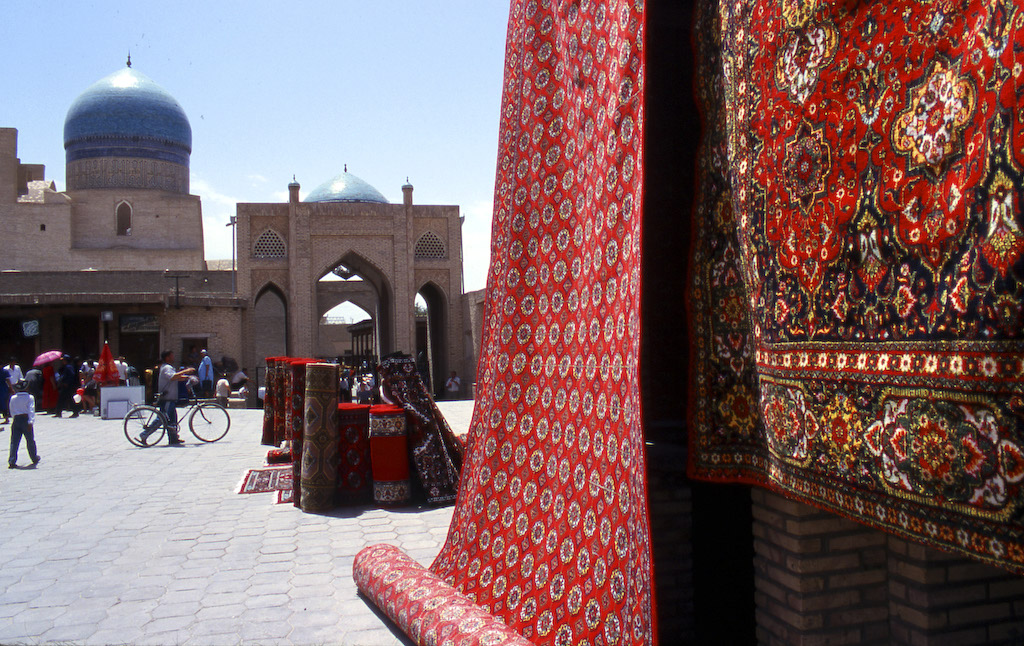
Bukhara was founded in 500 BC in the area now called the Ark. However, the Bukhara oasis had been inhabitated long before, since 3000 BC an advanced Bronze Age culture called the Sapalli Culture thrived at such sites as Varakhsha, Vardan, Paykend, and Ramitan. In 1500 BC a combination of factors: climatic drying, iron technology, and the arrival of Indo-Iraninan nomads triggered a population shift to the oasis from outlying areas. By 1000 BC, two groups, the Sapalli and Aryan people, had merged into a distinctive culture. Around 800 BC this new culture called Soghdian flourished in city-states along the Zaravshan Valley. By this time, three small fortified settlements at the place of present-day Bukhara had been built. By 500 BC these settlements had grown together and were enclosed by a wall, thus Bukhara has born.
The word "minaret" descends to Arabic "manara" ("lighthouse", or more literally "a place where something burn"). Probably an idea of minarets of Islam was adopted from "fire-towers" or lighthouses of previous epochs. In some of the oldest mosques, such as the Great mosque of Damascus, minarets originally served as watchtowers illuminated by torches (hence the derivation of the word from the Arabic "nur", meaning "light").
The architect, whose name was simply Bako, entwined his name (as well as the date of construction and the name of Arslan-khan) with epigraphic ornaments of the Minaret. Local inhabitants believe that the architect was buried somewhere among houses of the neighboring residential quarter. Bako made a minaret in the form of a circular-pillar brick tower, narrowing upwards, of 9 meters (29.53 feet) diameter at the bottom, 6 meters (19.69 feet) overhead and 45.6 meters (149.61 feet) high. There is a brick spiral staircase that twists up inside around the pillar, leading to the landing in sixteen-arched rotunda - skylight, which based on a magnificent stalactite cornice (sharafa). .The minaret, which draws visitors up its 105 steps to see a panoramic view of the city, was once the tallest structure in Central Asia. It has been called the “Tower of Death,” because, legend has it, executions were often performed by throwing the condemned from its heights. In truth, however, locals will tell you that only one such killing occurred from the tower.Bukhara, one of Uzbekistan’s treasures, is a place rich in history and dramatic architecture. The city’s most famous landmark, the Kalyan Minaret (dating back to 1127), is the greatest remnant of truly old Bukhara; Genghis Khan destroyed most of the city, but left the minaret standing, supposedly because he was struck by its beauty.
Yet the city has witnessed some brutal executions; perhaps the most infamous were the killings of British officers Col. Charles Stoddart and Capt. Arthur Conolly in 1842. Victims of a misunderstanding between the Emir of Bukhara and the British government (which failed to supply its emissaries with the appropriate gifts and royal letters of introduction), the two were imprisoned in the Bug Pit at the Zindan (city jail), then forced to dig their own graves before their ceremonial beheading in front of the Ark (the Emir’s palace).
The Ark now houses a museum on the city’s history, and the Zindan is now a tourist attraction, showcasing such skin-crawling rooms as the Bug Pit, a torture chamber and the dungeons.Over the centuries, destroyed structures at the site of the Ark have formed an artificial hill 18 meters (59 feet) high. Last rulers of Bukhara have built up the top layer with constructions, part of which we can see today. On a plan the shape of the Ark looks like irregular rectangle (perimeter of the walls – 789,60 metres (863,52 yards); area – 3,96 hectares (9,79 acres)).
According to the Persian epic poem Shahnameh the city was founded by King Siavush son of Shah Kavakhous, one of the mythical Iranian Shahs of the Pishdak Dynasty. As the legend goes Siavush was accused of seducing his mother by the Vizers. To test his innocence he underwent trial by fire. After emerging unscathed from the flames he crossed the Oxus into Turan. The king of Samarkand Afrosiab, gave Siavash his daughter Ferganiza and a vassal kingdom in the Bukhara Oasis. There he built the Ark, and surrounding city. Some years later Siavash was again accused of seducing his father-in-law's wife. Afrasiab killed Siavash, and buried his head under the Haysellers Gate. In retaliation Shah Kavakhous attacked Turan killed Afrasiab, and took his son and daughter-in-law back to Persia.
Also they say that before Afrasiab gave Siavush his daughter he stipulated that pretender should be able to build a fortress on piece of land under an ox-hide. However Siavush was very ingenious. He slit ox-hide into slender ribbons then he joined ends together and inside this ring he later built the Ark.Bukhara, with its population of a quarter of a million, is a major tourist attraction for travelers following the old Silk Road. Celebrating its 2,500th anniversary in 1997, the city has been working hard to put its best old face forward. And though Bukhara’s mud-colored buildings are often a let-down to visitors who’ve just seen the dazzling mosaics of Samarkand, the city’s subdued desert hues and centuries-old buildings exude their own exotic air of ancient culture.